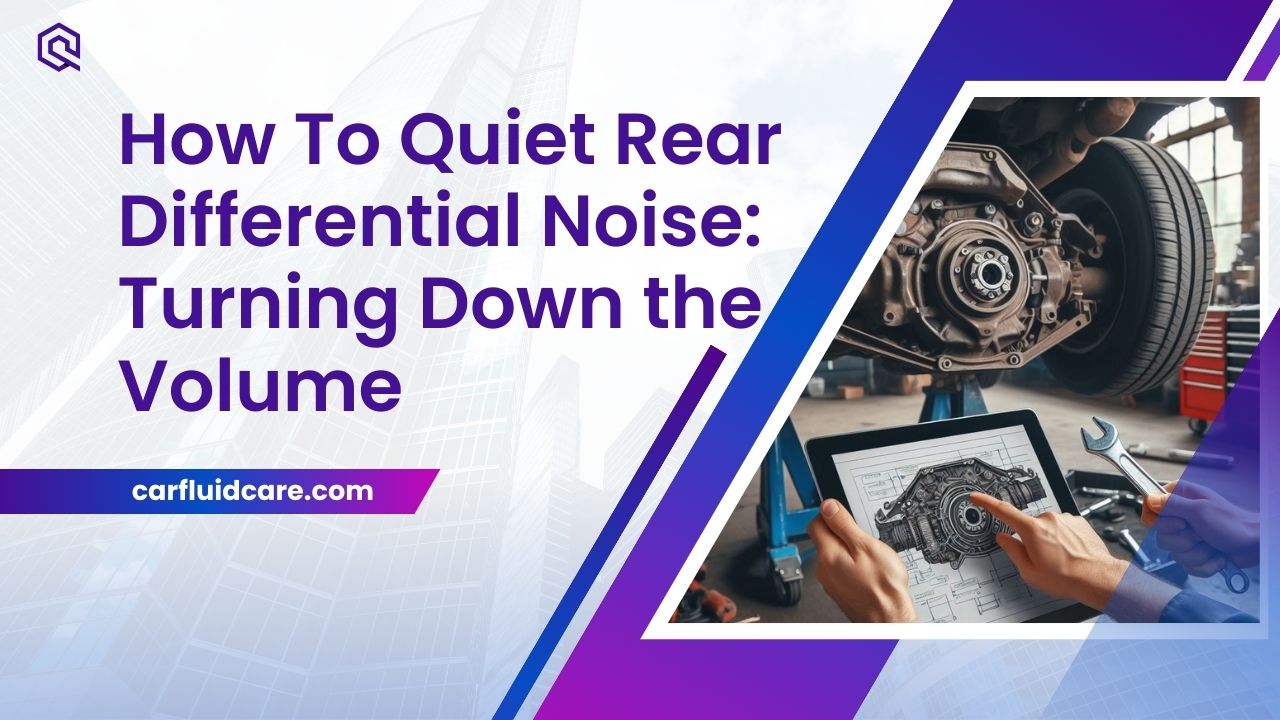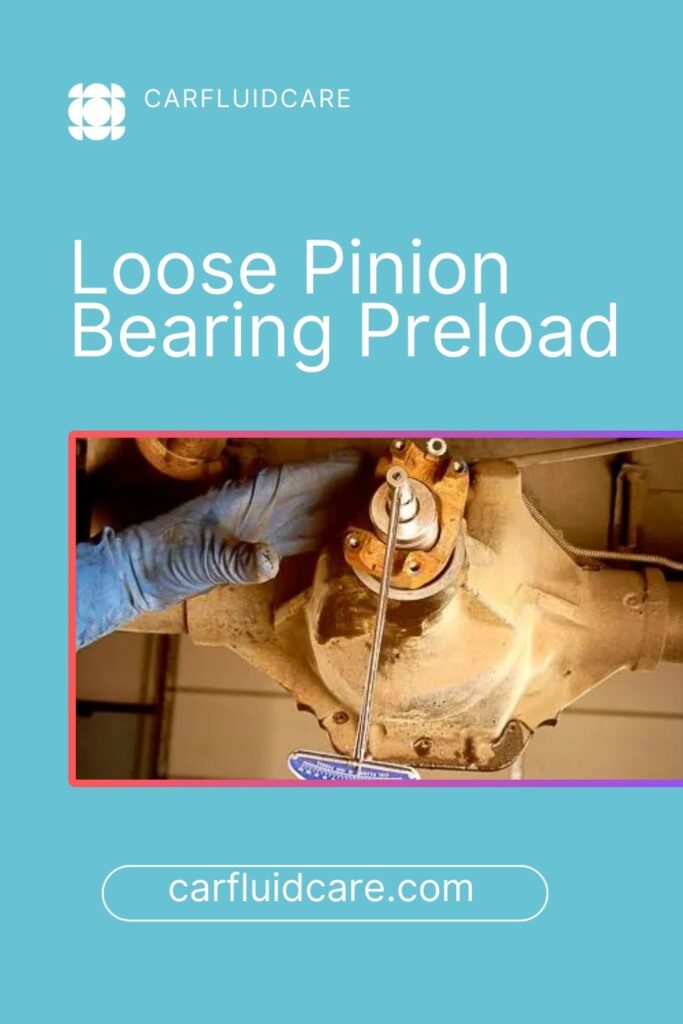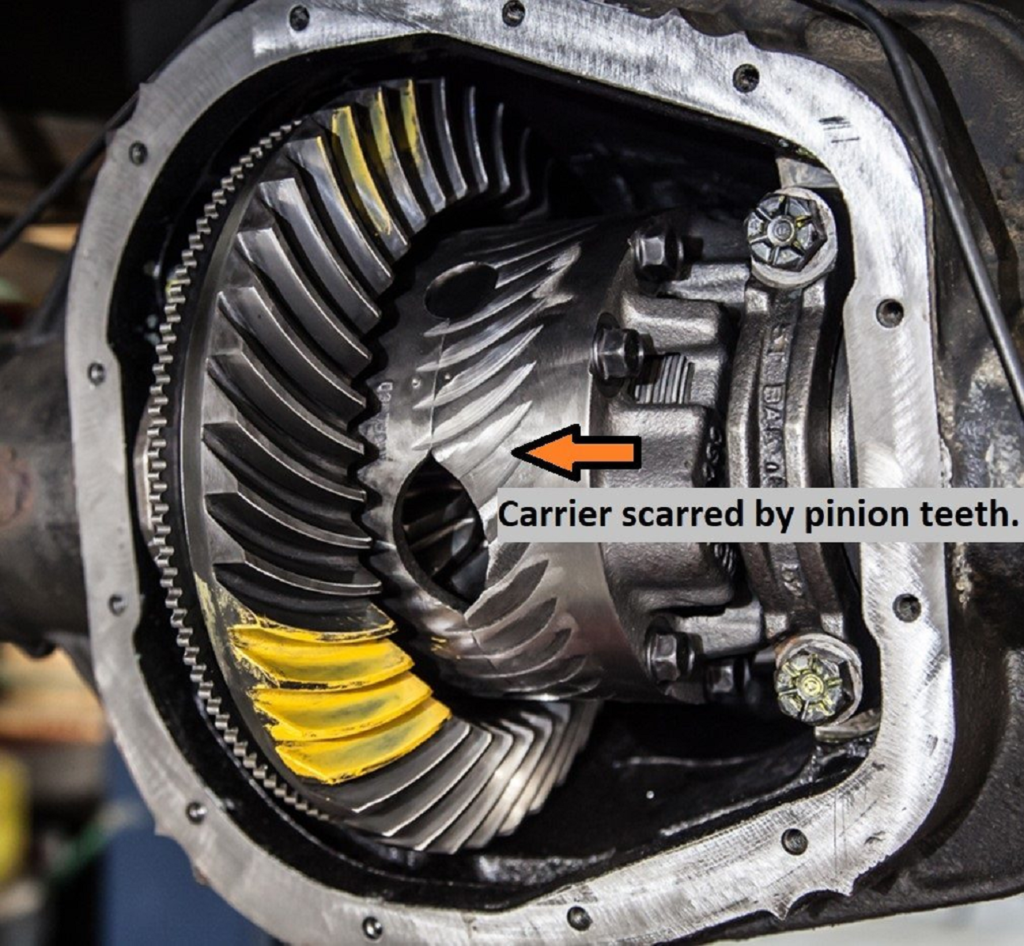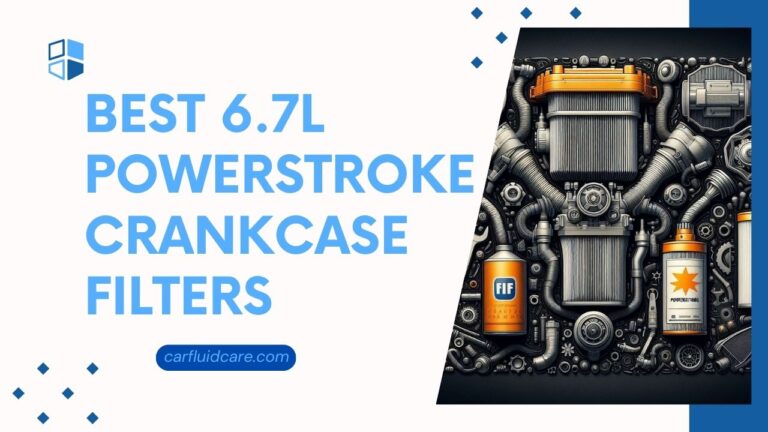How To Quiet Rear Differential Noise: Turning Down the Volume

Over time, rear differentials can develop noise issues, ranging from humming and whining to more ominous clunking sounds. But how to quiet rear differential noise?
To quiet rear differential noise, inspect and replace worn or damaged parts, add appropriate lubricant, and ensure proper tightness of fasteners.
We will explore these techniques, empowering you to identify and mitigate rear differential noise.
Additive To Quiet to rear Differential noise : K&W 402508 Trac Limited Slip Gear Oil Additive
This 7 fl oz solution is designed to tackle chattering differentials and enhance the overall performance of your gear oil. The Trans-X Posi Trac promises to maintain optimal limited-slip operation, reduce friction and wear.

Features
- Noise-Free Performance: The Trans-X Posi Trac is formulated to quiet chattering differentials, ensuring a noise-free driving experience.
- Enhanced Gear Oil Performance: This additive is crafted to improve the overall performance of your gear oil, providing a smoother and more efficient operation.
- Optimal Limited-Slip Operation: The Trans-X Posi Trac maintains the smooth operation of limited-slip differentials.
- Friction and Wear Reduction: This gear oil additive actively reduces friction, minimizing wear on essential components and extending the lifespan of your vehicle’s drivetrain.
- Overheating Prevention: The Trans-X Posi Trac helps eliminate overheating issues, ensuring your differential stays within the optimal temperature range for peak performance.
- Meets Industry Standards: Rest easy knowing that the Trans-X Posi Trac meets the specifications set by GM, Ford, and Chrysler, guaranteeing a product that adheres to rigorous quality standards.
Applications
Ideal for a wide range of vehicles, from everyday commuters to off-road enthusiasts.
Pros
- Quiets chattering differentials for a more enjoyable driving experience.
- Enhances the overall performance of gear oil, providing smoother operation.
- Maintains optimal limited-slip operation, ensuring consistent and reliable performance.
- Actively reduces friction and wear, extending the lifespan of essential components.
- Helps prevent overheating issues, promoting efficient and cool differential operation.
- Compatible with both conventional GL-5 and synthetic gear oils.
- Meets industry standards set by GM, Ford, and Chrysler for quality assurance.
Cons
- While the Trans-X Posi Trac excels in reducing chatter, individual results may vary based on the condition of the existing differential.
Read More About Oil Catch Can With Breather Or Without
How To Quiet Rear Differential Noise When Accelerating
Here are some steps you can take to address the issue:
1. Identify the Noise
First, try to identify the specific type of noise and its location. Is it a whining, clunking, grinding, or humming noise? Does it change with speed, turning, or acceleration? This information can help pinpoint the source of the problem.
2. Check Fluid Levels
Low or contaminated differential fluid can contribute to noise issues. Make sure the differential fluid is at the correct level and in good condition. If it’s low or dirty, replace it with the recommended type and weight. If the fluid is old or contaminated, draining and refilling with fresh, manufacturer-recommended fluid may help reduce noise.
3. Inspect for Leaks
Check for any leaks around the differential housing.
4. Tighten or Replace Loose Bolts:
Tighten them to the manufacturer’s specifications. If you find damaged bolts, replace them.
5. Check for Damaged U-Joints
Worn or damaged universal joints (U-joints) can produce clunking or clicking sounds. Inspect the U-joints for any play or signs of wear.
6. Worn bearings or gears
This is a more serious issue that may require professional repair. However, if the noise is severe or getting worse, it’s important to get it checked out by a mechanic to prevent further damage.
7. Loose components
Bolts or other parts within the differential housing can become loose over time, causing noise. Tightening them might solve the problem, but consult a repair manual or mechanic first.
8. Inspect the Differential Gears
Open the differential case and inspect the gears for wear, chipping, or damage. Check for worn bushings, shocks, or other suspension parts. Replace any damaged components.
9. Add Friction Modifier
Add a friction modifier to the differential fluid may help.
Rear Differential Noise On Acceleration
Here are some common reasons for rear differential noise on acceleration:
- Low or Contaminated Differential Fluid
- Worn or Failing Bearings
- Damaged Ring and Pinion Gears
- Loose or Worn Differential Mounts
- Incorrect Gear Setup
- Axle Issues
- Tire Issues
- Lubrication Issues
Will Thicker Oil Quiet A Rear Differential?
Using a thicker oil in the rear differential may potentially reduce noise by providing better lubrication and damping properties.
Differential Noise On Deceleration
Differential noise on deceleration can be caused by a number of factors, but some of the most common culprits include:
1. Loose Pinion Bearing Preload
The pinion bearing is responsible for supporting the pinion gear, which transmits power from the driveshaft to the ring gear. If the preload on the pinion bearing is too loose, it can cause the gear to wobble and create noise.

2. Worn Ring And Pinion Gears
The ring and pinion gears are the main gears in the differential, and they can wear out over time. This wear can cause noise, especially on deceleration when the gears are under less load.
3. Worn Carrier Bearings
The carrier bearings support the carrier, which holds the ring gear. If these bearings are worn, they can also cause noise.
4. Low Differential Fluid Level
The differential fluid helps to lubricate the gears and bearings, and a low fluid level can lead to increased wear and noise.
Differential Noise When Coasting
Here are some of the common culprits:
1. Incorrect Gear Mesh
This occurs when the ring and pinion gears don’t mesh properly, often due to incorrect setup during rebuild or excessive wear.
2. Worn or Damaged Gear Teeth
Over time, teeth on the ring and pinion gears can wear down, chip, or break, leading to irregular contact and generating noise.
3. Bearing Issues
Worn or damaged bearings within the differential, such as pinion bearings, carrier bearings, or axle bearings, can cause noise due to increased play and metal-to-metal contact.
4. Low Differential Fluid Level or Incorrect Fluid
Insufficient lubricant creates friction and heat, leading to noise and potential damage.
5. Other Potential Causes:
While less common, other possibilities include worn axle splines, damaged differential housing, or issues with the driveshaft.
Noisy Differential When Accelerating
Noisy differential during acceleration may indicate issues with gears or bearings. Check for low differential fluid, damaged gears, or worn bearings.
Noisy Differential Symptoms
Here are some common symptoms of a noisy differential:
1. Whining Noise
This is the most common symptom of a differential problem. The whining noise is typically caused by worn or damaged gear teeth, bearings, or a lack of lubrication.

2. Grinding Noise
A grinding noise is a more serious symptom than a whining noise and indicates that there is significant damage to the differential gears or bearings.
3. Vibration
Vibration can be caused by a number of drivetrain problems, including a noisy differential. Vibration may be felt in the steering wheel, seat, or floorboard.
4. Fluid Leaks
If you see fluid leaking from the differential, it is a sign that there is a problem. The leak could be coming from a damaged seal or a cracked housing.
Noisy Differential Sound
Here’s how different sounds might point to different issues:
1. Whining
This is the most common sound and often indicates:
- Worn or damaged gear teeth: The meshing of worn or chipped teeth creates a high-pitched whine.
- Incorrect gear mesh: Improperly set gears during rebuild or excessive wear can cause a similar whine.
- Low differential fluid: Lack of lubrication increases friction and produces a whining sound.
2. Grinding
A more serious sign, often implying:
- Severely worn or damaged gear teeth: Significant wear or breakage leads to metal-to-metal contact and a grinding sound.
- Bearing failure: Worn or damaged bearings within the differential can create a grinding noise due to increased play.
3. Clunking
Typically points to:
- Loose axle or driveshaft: Play in these components can cause clunking during movement, especially when taking turns or accelerating/decelerating.
- Worn carrier bearings: Excessive wear can create play and lead to clunking noises.
4. Other sounds
- Humming: Might indicate worn ring and pinion gears or carrier bearings.
- Growling: Could be a sign of worn axle bearings or issues with the driveshaft.
- Thumping: Can be caused by a damaged differential housing or worn axle splines (less common).
How To Fix Noisy Differential
Here are some common steps you can take to diagnose and address the problem:
Step 1: Identify the Noise
Is it a whining, grinding, or clunking sound? Different noises can indicate different problems.
Step 2: Check the Fluid Level
Low or contaminated differential fluid can cause noise. Check the fluid level and condition.
Step 3: Inspect for Leaks
Check for any leaks around the differential housing. Leaks can lead to low fluid levels and cause noise.
Step 4: Tighten Loose Bolts
Loose bolts or components can contribute to noise. Inspect and tighten any loose bolts.
Step 5: Check the Pinion Nut
If you hear a whining noise, the pinion nut may be loose.
Step 6: Inspect Bearings
Worn or damaged bearings can cause noise. Inspect the differential and axle bearings for signs of wear or damage. Replace any worn-out bearings.
Step 7: Examine the Ring and Pinion Gears:
Inspect the ring and pinion gears for signs of wear or damage. Worn gears can create noise.
Step 8: Check for Excessive Play
Excessive play in the differential can cause noise.
Step 9: Verify Proper Alignment
Misalignment of drivetrain components can lead to noise issues. Ensure that the differential is properly aligned with the rest of the drivetrain.
Rear Differential Noise Vs Wheel Bearing Noise
Some key differences can help you narrow down the culprit:
| Rear Differential Noise | Wheel Bearing Noise |
| The noise may change with vehicle speed and load (acceleration/deceleration). | The noise typically increases in intensity with vehicle speed. |
| Differential noise usually seems to come from the center rear of the vehicle. | Come from one specific wheel (front or rear) depending on the affected bearing. |
| ifferential noise typically doesn’t change significantly when turning corners. | While not a definitive test, jacking up the car and spinning the wheel by hand can sometimes help isolate the noise source. |
How Long Will A Whining Differential Last?
The lifespan of a whining differential varies, lasting from 100 yards to a few thousand miles. Timely maintenance and addressing issues can extend its durability.
Rear Differential Grinding Noise
Here’s a breakdown of potential causes and next steps:
Possible Causes
- Worn or damaged gear teeth
- Bearing failure
- Incorrect gear mesh
- Low differential fluid level or incorrect fluid
Can I Drive With A Noisy Diff?
Driving with a noisy differential may be possible, but it’s not ideal. Noise could indicate a potential issue, and continued driving may lead to more significant problems.
How Do You Remove Differential Noise?
To reduce or eliminate differential noise, inspect and replace worn bearings, check and refill lubricant, and address any gear issues. Seek professional assistance if necessary.
What Does A Damaged Differential Sound Like?
A damaged differential may produce sounds like humming, grinding, or whining. These noises typically indicate issues with gears or bearings and require prompt attention for inspection and repair.
What Are The Signs Of A Differential Going Out?
Here are some common signs of a failing or worn-out differential:
1. Unusual Noises
- Whining or howling
- Clunking or banging
2. Vibration
Excessive vibration, especially when turning or at certain speeds, may indicate a problem with the differential or the CV joints.
3. Difficulty turning
A differential issue can result in difficulty steering or a feeling of resistance when making turns.
4. Fluid leaks
Fluid leaks around the differential housing may be a sign of a seal or gasket failure. Loss of fluid can lead to inadequate lubrication and subsequent damage.
5. Uneven Tire Wear
Differential problems can cause uneven tire wear, as the wheels may not be receiving the appropriate amount of power or rotating at different speeds.
6. Warning Lights
Some modern vehicles are equipped with sensors that can detect issues with the differential and trigger warning lights on the dashboard.
7. Dragging Sensation
A dragging or binding sensation when driving may be a sign that the differential gears are not functioning correctly.
How Do I Know If My Rear Differential Needs Fluid?
Here are the steps you can follow to determine if your rear differential needs fluid:
1. Locate the Rear Differential
Identify the location of your rear differential. In most vehicles, it is positioned at the rear axle.
2. Identify the Fill Plug
Look for the fill plug on the rear differential. It is usually located higher up on the differential casing.
3. Remove the Fill Plug
Using the appropriate tools, carefully remove the fill plug.
4. Check the Fluid Level
The level should be just below the edge of the fill hole. If you can’t feel any fluid or if the level is significantly below the fill hole, it may indicate a low fluid level.
5. Top Up if Necessary
If the fluid level is low, carefully add the recommended type of differential fluid.
How To Quiet Rear Differential Noise At Low Speed
To address rear differential noise at low speeds, check the fluid level and condition, inspect for leaks or damage, and consider using a higher-quality lubricant.
How Can You Reduce Noise By Driving?
To reduce noise while driving, keep windows closed, use noise-canceling technology or earplugs. Limiting high speeds and avoiding rough terrain can also contribute to a quieter driving experience.
How Do You Check For Differential Problems?
Here’s a general guide on how to check for differential problems:
1. Visual Inspection
- Underbody examination
- Fluid check
- Component wear
2. Performance Tests
- Road test
- Lift inspection
- Magnetic drain plug inspection
3. Specialized Checks
- Gear backlash measurement: Specialized tools measure the play between gears, which can reveal excessive wear or incorrect meshing.
- Bearing preload check: Specific procedures assess the preload on bearings.
- Driveline vibration analysis: Advanced equipment can detect and pinpoint abnormal vibrations originating from the differential or other drivetrain components.
Read Also Unveiling The Top 8 Friction Modifier Additives For Optimal Performance
FAQ
How do I quiet down a noisy rear end?
To reduce noise in a rear end, check for loose or damaged components like exhaust parts, suspension elements, or wheel bearings. Inspect and tighten connections, replace worn parts, or seek professional assistance if needed.
Why does my front differential make a grinding noise?
A grinding noise from the front differential could indicate issues such as worn bearings, damaged gears, or insufficient lubrication.
What oil to use in a noisy differential?
Penrite Gear Oil 85W-140 is a suitable choice for a noisy differential. Its viscosity and additives help reduce friction and wear, potentially improving the performance and quieting the differential.
Can you use Lucas oil stabilizer in a noisy differential?
Yes, Lucas Oil Stabilizer can be used in a noisy differential to help reduce friction and wear, potentially improving performance and quieting the noise.
Which gear oil is thicker 75W90 or 75W140?
75W140 oil is thicker than 75W90 oil at both low and high temperatures. This is because it has a higher viscosity at both temperatures.
What fluid should never be used in a rear differential?
Engine oil should never be used in a rear differential. Rear differentials require gear oil specifically designed for their unique lubrication needs to ensure proper function and longevity.
Can synthetic oil reduce engine noise?
Yes, synthetic oil can help reduce engine noise. Its advanced formulation and consistent molecular structure provide better lubrication, reducing friction and minimizing wear, which can contribute to a quieter engine.
What does a bad rear differential sound like?
A bad rear differential may produce a whining or grinding noise, especially during turns.
What causes a rear differential to whine?
A rear differential may whine due to worn or damaged bearings, gears, or seals. Insufficient lubrication, incorrect gear mesh, or misalignment can also contribute to the whining noise in the differential.
Why does my rear end make a noise when I turn?
The noise from your rear end when turning could be due to various reasons, such as worn-out suspension components, damaged wheel bearings, or issues with the differential. It’s advisable to have it inspected by a mechanic.
Why does my rear differential make noise when accelerating?
Possible reasons for rear differential noise during acceleration include worn or damaged gears, lack of lubrication, or issues with bearings.
How long can i drive with pinion bearing noise?
Driving with pinion bearing noise can cause further damage to the vehicle’s differential. It’s risky to go beyond 1,000 miles; prompt inspection and repair are recommended.
How much oil do I put in my rear differential?
For your rear differential, use 3 quarts of oil.
Does differential affect acceleration?
Yes, differential plays a crucial role in controlling wheel speed variations, allowing for smooth turns and preventing wheel slippage, thereby influencing acceleration in vehicles.
Is it worth fixing a rear differential?
It depends on the extent of the damage and the cost of repairs. Evaluate the vehicle’s overall condition and value before deciding to fix the rear differential.

Conclusion
Addressing rear differential noise involves a systematic approach to identify, inspect, and resolve underlying issues. Regular maintenance, such as checking fluid levels, inspecting for leaks, and tightening loose components, can contribute to a quieter driving experience.
Resources:
How to Diagnose and Repair a Noisy Rear End: https://www.motortrend.com/how-to/how-to-diagnose-and-repair-a-noisy-rear-end/
Best lube to quiet down singing rear diff?: https://bobistheoilguy.com/forums/threads/engine-sounds-and-drives-way-better-after-oil-change.319473/





